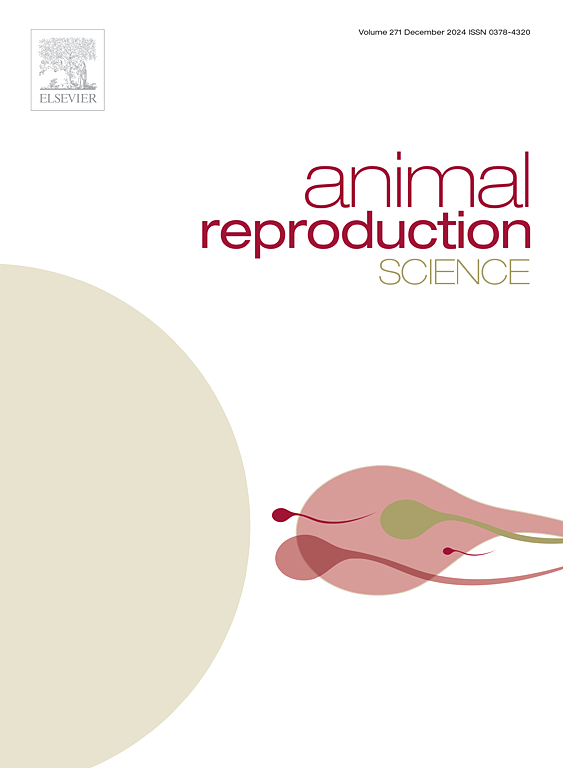Age-related changes in semen characteristics of selected Slovak geese breeds
IF 3.3
2区 农林科学
Q1 AGRICULTURE, DAIRY & ANIMAL SCIENCE
引用次数: 0
Abstract
This paper strove to characterize and compare ejaculates collected from two geese breeds over the period of two years in the context of selected traditional, biochemical, oxidative, bacteriological, and immunological properties. Slovak white and Suchovy ganders were selected for sperm quality evaluation, while bacteria were characterized using the matrix-assisted laser desorption/ionization time-of-flight mass spectrometry. Oxidative profile of semen was assessed using chemiluminescent and colorimetric protocols. Levels of pro-inflammatory cytokines and antibacterial proteins were evaluated with the enzyme-linked immunosorbent assay. Seminal plasma biochemistry was assessed with an automated clinical chemistry analyzer. Overall, lower semen quality was found in the Slovak white breed and during the first year of semen collection in both breeds. At the same time, the sperm motility was in a strong positive correlation with the plasma membrane integrity (P < 0.0001), whilst being negatively associated with the bacterial load (P = 0.0056), reactive oxygen species production (P < 0.0001), DNA fragmentation (P < 0.0001) and the levels of interleukin-1 (P < 0.0001) and C-reactive protein (P < 0.0001). Higher semen quality in ganders was accompanied by increased seminal plasma levels of lysozyme (P < 0.0001), cathelicidin (P < 0.0001), calcium (P < 0.01), magnesium (P < 0.01 in the case of the Suchovy breed), phosphorus (P < 0.001), total proteins (P < 0.0001 with respect to the Slovak white breed; P < 0.01 with regards to the Suchovy breed) and cholesterol (P < 0.05), and a decreased activity of aspartate transaminase (P < 0.0001). We may conclude that semen of overall better quality was obtained during the second year of semen collection as opposed to the first year in ganders of both selected goose breeds.
选定斯洛伐克鹅品种精液特征的年龄相关变化
本文从传统、生化、氧化、细菌学和免疫学等方面对两种鹅的射精进行了表征和比较。选择斯洛伐克白公鹅和苏楚维公鹅进行精子质量评估,而细菌则使用基质辅助激光解吸/电离飞行时间质谱法进行表征。使用化学发光法和比色法评估精液的氧化谱。用酶联免疫吸附法评估促炎细胞因子和抗菌蛋白的水平。用全自动临床化学分析仪评估精浆生化。总体而言,斯洛伐克白犬的精液质量较低,这两个品种在采集精液的第一年都是如此。同时,精子的运动性与质膜完整性有很强的正相关关系(P & lt; 0.0001),而与细菌负荷负相关(P = 0.0056),活性氧产量(P & lt; 0.0001),DNA碎片(P & lt; 0.0001)的水平(P & lt; 0.0001)及c反应蛋白(P & lt; 0.0001)。时过境迁是伴随着更高的精液质量精浆溶菌酶水平增加(P & lt; 0.0001),抗菌肽(P & lt; 0.0001),钙(P & lt; 0.01),镁(P & lt; 0.01 Suchovy品种),磷(P & lt; 0.001)、总蛋白(P & lt; 0.0001对斯洛伐克白色品种;(P <; 0.01)和胆固醇(P <; 0.05),天冬氨酸转氨酶活性降低(P <; 0.0001)。我们可以得出结论,两种鹅品种的雄鹅在精液收集的第二年获得的精液质量总体上比第一年更好。
本文章由计算机程序翻译,如有差异,请以英文原文为准。
求助全文
约1分钟内获得全文
求助全文
来源期刊

Animal Reproduction Science
农林科学-奶制品与动物科学
CiteScore
4.50
自引率
9.10%
发文量
136
审稿时长
54 days
期刊介绍:
Animal Reproduction Science publishes results from studies relating to reproduction and fertility in animals. This includes both fundamental research and applied studies, including management practices that increase our understanding of the biology and manipulation of reproduction. Manuscripts should go into depth in the mechanisms involved in the research reported, rather than a give a mere description of findings. The focus is on animals that are useful to humans including food- and fibre-producing; companion/recreational; captive; and endangered species including zoo animals, but excluding laboratory animals unless the results of the study provide new information that impacts the basic understanding of the biology or manipulation of reproduction.
The journal''s scope includes the study of reproductive physiology and endocrinology, reproductive cycles, natural and artificial control of reproduction, preservation and use of gametes and embryos, pregnancy and parturition, infertility and sterility, diagnostic and therapeutic techniques.
The Editorial Board of Animal Reproduction Science has decided not to publish papers in which there is an exclusive examination of the in vitro development of oocytes and embryos; however, there will be consideration of papers that include in vitro studies where the source of the oocytes and/or development of the embryos beyond the blastocyst stage is part of the experimental design.
 求助内容:
求助内容: 应助结果提醒方式:
应助结果提醒方式:


